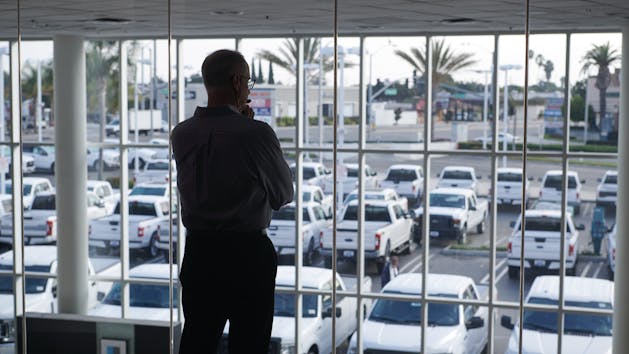Make sure you and your fleet are prepared for the International Roadcheck with our free guide.
Prepare for International Roadcheck 2019
International Roadcheck is right around the corner—this annual event sponsored by the Commercial Vehicle Safety Alliance (CVSA) includes commercial motor vehicle inspections across North America over a three-day period. Taking place June 4-6, 2019, the inspections will encompass a comprehensive 37-step procedure which includes items related to the vehicle, driver, and cargo safety and more. In addition, every year one violations category is especially emphasized, and this year the safety inspections will focus on violations related to steering and suspension systems and their importance to highway safety.
As part of International Roadcheck 2019, federal, state, provincial and local officers will perform Level I Inspections around the clock for 72 hours beginning June 4. Level I inspections are the most thorough and include the examination of driver compliance and vehicle safety-related regulations. During this time period, nearly 15 trucks or buses will be inspected, on average, every minute.1
Here’s how much of an impact these inspections can have on a fleet: last year the top three out-of-service vehicle violations were for brake systems (28.4%), tire and wheels (19.1%) and brake adjustment (16.3%), and the top three driver-related violations were for HOS (43.7%), wrong class license (21.4%) and false record of duty status (10.2%).2 Of Level I inspections, 21.6% of vehicles and 3.9% of drivers were placed out of service.2 That’s why it’s important to know what to expect and prepare for it.
During vehicle inspections, officials will check a number of systems and components, including:
- Brake systems
- Cargo securement
- Fuel systems
- Lighting devices
- Tire condition
- And more
Drivers should also be ready to provide the following items to inspectors:
- Valid Commercial Driver’s License (CDL)
- Valid Federal Medical Certificate
- HOS documentation
- Motor carrier registration
- Shipping papers/documentation
- And more
To ready your fleet, make sure that vehicles are in the best shape possible before they fall under inspector scrutiny.
- Prepare your equipment:
- Keep your vehicle as neat and clean as possible
- Conduct a proper and thorough pre-trip inspection
- Pay particular attention to:
- Vehicle lighting
- Brakes
- Wheels, tires and rims
- Any observable defects
Of course, fleet safety is a critical issue impacting companies, drivers and fleets year-round. So, it’s also important to stay on top of the considerations and technologies that can positively impact vehicle safety 365 days a year.
Keep fleet safety top of mind year round
While the yearly International Roadcheck shines an immediate spotlight on fleet safety, it’s a crucial component to the success of every fleet-dependent business and should be a top priority every day. Fleet owners and managers are tasked with overseeing every aspect of vehicle safety and, depending on the size of the fleet, that can be daunting.
Turning to technology, like GPS tracking, can help. Here are the key fleet safety aspects every organization should keep in mind—all which can become easier to manage with the right technology:
Improving driver behavior
Keeping track of driver locations while they’re behind the wheel while monitoring how they’re driving and handling their vehicles is integral to ensuring fleet safety. Telematics technology can help your organization gather all of this information at the touch of a button while providing alerts when drivers are speeding or driving harshly. In addition, customizable reports and dashboards let you view summarized safety-related data and aid in creating benchmarks to assist with fleet safety goals.
This insight into safety-related data can inform driver training and help you establish behavior best practices to reduce your business risk and keep your drivers and vehicles better protected while on the road. Specifically, it can help to:
- Reduce speeding
- Compare vehicle speeds against posted speed limits along vehicle routes
- Receive automatic speeding alerts when drivers exceed preset thresholds
- Track speeding incidents by driver and vehicle
- Use historic speeding reports to coach/train employees
- Curb hard braking and acceleration
- Identify when/where hard braking or acceleration events occur
- Receive automatic alerts via text or email
- Create customizable driver behavior reports
- Use hard data to coach drivers on ways to improve
- Track seat belt compliance
- Seat belts are a proven life-saving safety measure
- Fleet management software can integrate seat belt usage into safety programs
- Leverage telematics in combination with vehicle diagnostics to remotely track and measure seat belt use
- Get up-to-the-minute reporting on which drivers are complying with company policies and state laws
- Protect drivers in emergencies
- Breakdowns or accidents can happen due to bad weather, vehicle malfunction, poor visibility or driver error
- Onboard telematics means you—and emergency personnel or roadside assistance if required—can immediately pinpoint the exact vehicle location so help can arrive more quickly
Implementing a safety program
Data transparency lets you formulate the best plan of action when it comes to establishing a fleet safety program. By gathering and analyzing information recorded by an integrated GPS system, you can better determine the specific safety metrics that apply to your fleet and your business.
These are some of the metrics you might want to consider including in a fleet-wide safety program:
- Amount of money spent on speeding fines and accident costs annually
- Number of speeding incidents your fleet has had over the past year
- Total number of accidents your fleet experiences annually
- Amount of fuel used per vehicle on an annual basis
- Average cost of vehicle maintenance and repairs
- Vehicle maintenance repairs by type
- How long vehicles have spent in the garage due to maintenance
- Total number of vehicle thefts annually
- Specific drivers who speed or are prone to accidents
- Details of good driving behaviors you have seen your drivers demonstrate
Sources
1https://cvsa.org/program/programs/international-roadcheck/
2https://cvsa.org/news-entry/2018-roadcheck-results
Find out how our platform gives you the visibility you need to get more done.




